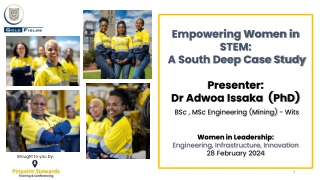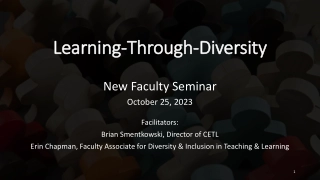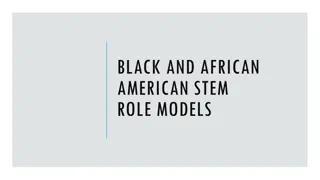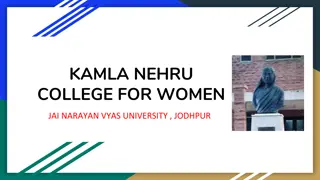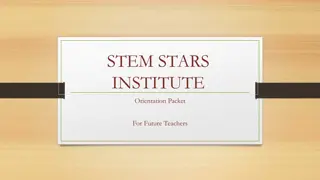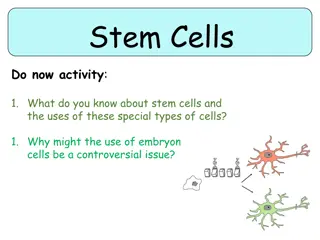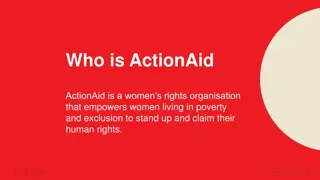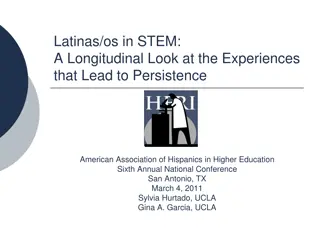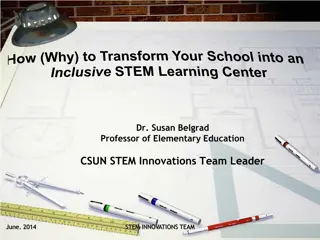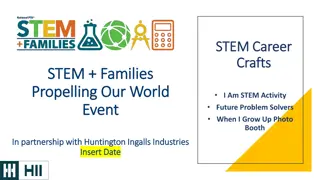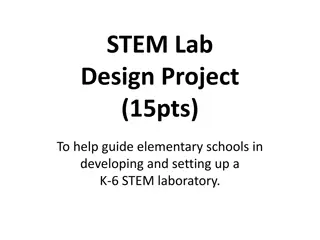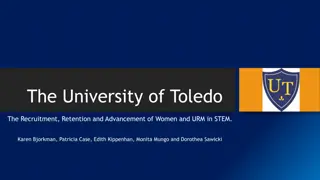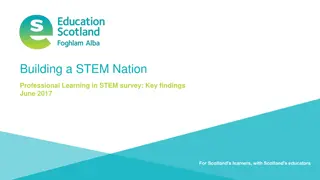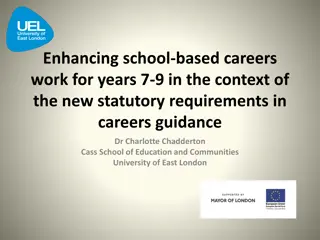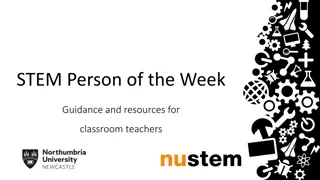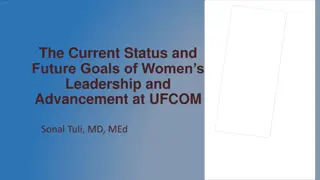Empowering Women in Academic STEM Careers
To develop systemic approaches for increasing women's representation and advancement in STEM academic careers, focusing on gender equity within academic environments. The goal is to create sustainable change through innovative organizational approaches that encompass all STEM disciplines and involve all faculty and administrators. Baseline data is crucial for proposing impactful projects. Projects should address intersectionality and include original research components.
Download Presentation

Please find below an Image/Link to download the presentation.
The content on the website is provided AS IS for your information and personal use only. It may not be sold, licensed, or shared on other websites without obtaining consent from the author.If you encounter any issues during the download, it is possible that the publisher has removed the file from their server.
You are allowed to download the files provided on this website for personal or commercial use, subject to the condition that they are used lawfully. All files are the property of their respective owners.
The content on the website is provided AS IS for your information and personal use only. It may not be sold, licensed, or shared on other websites without obtaining consent from the author.
E N D
Presentation Transcript
Departure from prior programs with goals related to increasing numbers of women in academics (1980 to 2000) Starting with passage of Science & Technology Equal Opportunities Act of 1980 Visiting Professorships for Women in Science and Engineering (1982-1997) Research Planning Grants and Career Advancement Grants for Women Scientists and Engineers (1986-1998) Faculty Grants for Women Scientists and Engineers (1990-1991) Professional Opportunities for Women in Research and Education (1997-2000) ADVANCE Fellowships (2001-2003) ADVANCE Institutional Transformation track represented a switch to a focus on the organizations within which academic careers are experienced fix institutions of higher education rather than fix women ADVANCE Institutional Transformation (2001-present)
To develop systemic approaches to increase the representation and advancement of women in academic STEM careers To contribute to and inform the knowledge base on gender equity in academic environments To create positive and sustainable change in academic climates
Innovative systemic organizational approaches that include all STEM disciplines and are institution-wide designed to increase the participation and advancement of women in STEM academic careers. All faculty, tenure and non-tenure can be included Projects targeting the intersectionality of gender and race, ethnicity, disability, and LGBTQ are encouraged All faculty and administrators men and women should be involved in the project activities Proposed activities must be based on and justified by: The institution s data and identified issues in academic career outcomes at your institution; and The relevant research on organizational change and barriers to participation and advancement in STEM academics. All projects must include an original research component related to the project design and goals. Up to 5 year projects with appropriate budgets for the proposed scope
Baseline data is critical in an IT proposal. Numbers of faculty at various ranks in each department. Search and hiring data. Start up packages and salaries. Promotion and tenure data. National pool data. The data to be included in the proposal will depend on the types of activities that are proposed. The IT data toolkit: http://www.nmsu.edu/~advprog/data%20&%20toolkit.htm Can help identify important baseline data to include in an IT proposal. Developed for reporting purposes by NMSU and other IT grantees. Note that the toolkit may not include all the data that should be included in your proposal. 5
Reviewing and revising policies such as recruitment, retention, career flexibility, promotion and tenure Developing work/life programs such as dual career hiring programs Establishing, revising, formalizing mentoring programs for faculty at all career stages Providing professional development opportunities for faculty Training for departmental leaders and members of P&T and search committees Conducting climate surveys and other data collection and analysis Conducting related social science research
How significant will the contribution of the study of the proposed innovative components and other IT activities be to the institutional transformation knowledge base? How strong are the indicators of institutional readiness for institutional transformation and commitment to the project activities and goals? How well are the proposed activities linked to the institutional context and data? How well is the relevant literature (from evaluation, education, behavioral, social and economic sciences, as appropriate) inform the design of the proposed innovative components and other IT activities? If women from special populations are included, how likely are the proposed activities to target their unique circumstances? Are mechanisms planned that ensure long-term sustainability beyond the duration of the funded project? Is the current proposal devoid of significant budgetary overlap with previous ADVANCE PAID or PLAN funding (if applicable)?
Assessment activities to document and understand institutional problems and the development and implementation of strategies adapted from other ADVANCE projects or other effective strategies Examples of project activities: Climate surveys to establish baseline data Data collection and analysis Planning meetings with stakeholders Site visits and research to identity potential strategies Limited to institutions that are eligible for Title III and V of HEA funds from U.S. Dept of Ed Mostly MSIs, predominantly undergraduate institutions, and community colleges Up to 3 years and up to $250,000 total
Collection and analysis of baseline data Climate surveys Planning meetings with stakeholders Training and development of proposal team Reviewing social science literature and current IT site strategies Site visits to exemplar institutions Consulting experts on gender equity and organizational change
How strong are the indicators of institutional commitment to the project activities and goals? If women from special populations are included, how likely are the proposed activities to target their unique circumstances? How likely is this project to catalyze sustained institutional transformation at the institution? Are mechanisms and strategies included that ensure long-term sustainability beyond the duration of the funded project?
Partnerships for Learning and Adaptation Networks: Adapt strategies that have evidence of effectiveness from the literature or from previous ADVANCE to enhance gender equity in STEM academics. Learn from the implementation in new contexts to determine what works, why, in what context(s), and for what populations. Networks are the proposed community of adaptors of the activity. PLAN D proposals focus on one STEM discipline Professional societies are eligible to participate as partners PLAN IHE proposals focus on IHEs Can focus on one discipline, subset of STEM, or all STEM disciplines Up to five years up to $750,000 total Another PLAN competition is anticipated for 2016 11
How well did the proposer demonstrate the effectiveness and/or lessons learned of the strategies and methods chosen to be adapted? How well did the proposer establish the significance of adapting the strategies and methods to the proposed context(s)? How well did the relevant literature (from evaluation, education, behavioral, social and economic sciences, as appropriate) inform the design of the PLAN activity and knowledge-building? If women from special populations are included, how likely are the proposed activities to target their unique circumstances? Are mechanisms planned and explained that ensure long-term sustainability beyond the duration of the funded project? Are the resources maximally shared between/among partnering institutions? Is there adequate representation of all partner institutions in the leadership of the project? Is adequate attention paid to the unique institutional characteristics of all partner institutions; are these nuances addressed in the proposed strategies to be implemented? Is there balance between the adaptation and learning components to maximize the potential for adding to the knowledge base? For PLAN D proposals, what is the likelihood of replication with other disciplines?
IT-Catalyst Due Date: October 5, 2015 IT Due Date: November 5, 2015 Project Title 1. Synopsis - Description of proposed project (2,500 characters max) 2. Other Comments (2,500 characters max) List of senior project personnel and proposed roles for each List of partner institutions and organizations and description of involvement Other information such as known conflicts and areas of specialized expertise pertinent for the review process can also be included. IT Catalyst Letters of Intent: must include a statement certifying that the submitting institution is in compliance with organizational limits 3. Contact Information for: Point of Contact (and an alternate) for NSF inquiries PI for the project 4.
IT projects must include innovative components. Leadership commitment to the activities to be conducted and the personnel to be involved. Social science expertise is involved in developing the proposal and in the leadership team once funded. Includes a plan for formative and summative evaluation, including external evaluation Adequate management plan for implementation 14
Understanding of the Problem Leadership Commitment Familiarity w/Prior ADVANCE awards Leadership Expertise x x x x IT x x x x ITC Description of the institutional context Basic faculty data Issues for faculty to be addressed Potential goals for future IT project (ITC only) Demonstrated commitment from leadership (president, provost) to ADVANCE project and personnel to be involved. Familiarity with strategies of earlier ADVANCE awardees and relevant literature Team with appropriate mix of expertise Junior and senior faculty involvement Involvement of key administrative decision makers Social science expertise involved in design and implementation Activities consistent with Institutional context Project goals Conceptual framework Leadership team capabilities
Realistic Plans Evaluation Plan Data x x x IT x x x ITC Realistic timeline, management plan, budget Plan for formative and summative evaluations (at minimum) Most IT projects include internal and external evaluation components See Online Evaluation Resource Library See ADVANCE Evaluation Toolkit Baseline data critical for IT # of faculty at professorial rank, academic department Search/hiring data Start-up package data Promotion/tenure data Understanding of types of data to be collected Relevant data on special populations, if proposed See ADVANCE Indicators Toolkit
Innovation Need for Support x IT x ITC Convince reviewers and NSF that project is innovative and important Develop/study new transformational strategy Provide unique contribution to understanding transformation, i.e., Different institution type Different populations Convincing argument of historical lack of resources Contribute to knowledge base on women in S&E careers Strong social science research component (5 page supplement)
Description IT ITC Inadequate description of the roles and responsibilities of various members of the leadership team and other personnel. x x A plan to develop materials and activities without using relevant existing resources. x x Leadership team that is not sufficiently broad for the kinds of activities and goals proposed. Underestimation of the time and human resources to set up and maintain an ADVANCE project. x x x x No, or inappropriate, data provided in the proposal x x Not using/exceeding fifteen page limitation x x Lack of cohesiveness between social science research and ADVANCE activities x Lack of an innovative dimension with a strong proposal to study the innovation. x
Letters of Commitment from key administrators Not letters of support Postdoctoral mentoring plan NSF required if a postdoc is supported by project funds Data management plan (NSF required) External evaluator s CV(s) IT only - five-page description of social science research: the disciplinary and conceptual framework for the study; a discussion of the theory and hypotheses grounding the research; the proposed methods to test the hypotheses; the expected findings; and to what extent the results and data will be disaggregated for multiple characteristics such as race, ethnicity, sexual orientation, disability, foreign- born or foreign-trained, in addition to gender.
Projects involving research with human subjects must ensure that subjects are protected from research risks in conformance with the relevant federal policy known as the Common Rule (Federal Policy for the Protection of Human Subjects, 45 CFR 690) All projects involving human subjects must either (1) have approval from the organization's Institutional Review Board (IRB) before issuance of an NSF award or, (2) must affirm that the IRB has declared the research exempt from IRB review, in accordance with the applicable subsection, as established in section 101(b) of the Common Rule.
NSF ADVANCE Program web page http://www.nsf.gov/ADVANCE ADVANCE Web Portal for access to materials http://www.portal.advance.vt.edu/ Program Office ADVANCE@nsf.gov Jessie DeAro jdearo@nsf.gov Cynthia Douglas cdouglas@nsf.gov
Equitable Career Support For Individuals Mentoring, leadership development, network development, research support Empowerment of Individuals & Leaders Tools and resources to improve decision making, knowledge of social science research on barriers to gender equity Improvement of Institutional Structures Systematic data collection, reviewing and revising policy, accountability mechanisms Work Life Support Policies Dual career hiring, flexible career policies, dependent care leave policies
Strategies Establish formal mentoring structures and provide recognition of service for time and effort of mentors Develop mechanisms to recognize professional excellence of both female and male faculty Provide workshops, training, and coaching on the tenure and promotion processes to all faculty Implement leadership development, career coaching and network building programs 23
Strategies Provide tools and resources to address the gender equity barriers to faculty, department leaders, and institutional administrators Provide training on effective strategies to reduce the stressors that result in a greater reliance on implicit biases when making decisions, especially in search committees and promotion and tenure committees 24
Strategies Review, revise, and increase the transparency and effective implementation of policies and procedures (particularly recruitment, promotion and tenure policies) Develop systematic and recurring institutional data collection and reporting of faculty data and climate surveys, disaggregated by demographics and rank for use in decision- making Incorporate equity and diversity responsibilities and accountability into institution-wide administrative positions, departmental leadership, as well as faculty to ensure equitable distribution of resources, responsibilities, and commitment 25
Strategies Implement flexible career policies that address the needs identified by the faculty Develop career and life transition support programs Establish dual-career hiring programs tailored to the institution and region Encourage department and institutional flexibility and support for dependent-care responsibilities Create institutional and departmental climates that encourage faculty to take advantage of work-life programs and ensure that there are no negative impacts on a faculty member s career for participating in the programs 26


